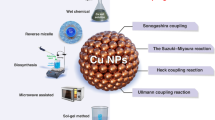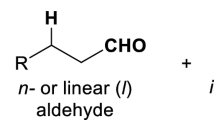Abstract
The thermal degradation of three monosubstituted hexacarbonyl complexes, M(CO)5py (where M=Cr, Mo, and W; py=pyridine) has been studied by thermogravimetry (TG) and differential scanning calorimetry (DSC) and their results reported. It was found that for each of the three complexes studied, the starting material M(CO)6 was formed which immediately sublimed unchanged with or without concomitant loss of carbonyl (CO) ligands to give the first large weight loss step. This was closely followed by the volatilisation of the pyridine ligands and at higher temperatures the loss of further CO ligands. The enthalpy changes associated with the above-mentioned steps are reported. The conversion of M(CO)5py to M(CO)6 and other products was confirmed by the analysis of residue after pyrolysis in a tube furnace under conditions similar to those observed in TG experiments.
Zusammenfassung
Der thermische Abbau von drei monosubstituierten Hexacarbonylkomplexen der allgemeinen Formel M(CO)5py (mit M=Cr, Mo und W; py=Pyridin) wurden mittels TG und DSC untersucht. Von jeder der drei Komplexe wird die Ausgangssubstanz M(CO)6 erhalten, die sofort unverändert mit oder ohne gleichzeitigem Verlust an Carbonyl (CO)-Liganden sublimiert und die erste große Gewichtsverluststufe ergibt. Diesem Schritt folgt gleich die Verflüchtigung des Pyridinliganden und bei höheren Temperaturen die Abgabe weiterer CO-Liganden. Die mit den genannten Schritten einhergehenden Enthalpieveränderungen werden mitgeteilt. Die Umwandlung von M(CO)5py zu M(CO)6 und anderen Produkten wurden durch Analyse des Rückstandes nach der Pyrolyse in einem Röhrenofen unter ähnlichen Bedingungen wie in den TG-Versuchen bestätigt.
Резюме
Методами ТГ и ДСК изуч ено термическое разложение трех моно замещенных гексакарбонильных к омплексов М(СО)5ру, где M=хром, молибден и вольфрам, а ру=пиридин. Найдено, что разложен ие комплексов протек ает с образованием исходн ого гексакарбонила, который сразу же субл имируется неизменны м или же с сопутствующей потер ей карбонильных лигандов, давая тем са мым первию стадию с бо льшой потерей веса. Близко к этой стадии происходило выделен ие пиридиновых лиган дов, а при более высоких темпер атурах происходило дальнейшее выделени е карбонильных лиган дов. Приведены изменения энтальпии для вышеупомянутых стад ий. Образование гекса карбонилов металлов и других про дуктов разложения было подтверждено ан ализом конечных прод уктов пиролиза в трубчатой печи в условиях подобных таковым, как и в методе ТГ.
Similar content being viewed by others
References
M. J. Workulich and J. D. Atwood, J. Organomet. Chem., 219 (1981) 53–59.
A. K. Smith, J. M. Basset and P. M. Maitlis, J. Mol. Catal., 2 (1977) 223.
W. A. Zanobi, E. Mantoni and N. Palladino, J. Mol. Catal., 3 (1977/78) 285.
W. Strohmeier and P. Hartman, Z. Naturforsch., 19b, 10 (1964) 65w.
W. Strohmeier and P. Hartman, Z. Naturforsch., 19b (10) (1964) 822–6.
W. Strohmeier and H. Gruebel, Z. Naturforsch., B21 (8) (1966) 807–8.
M. F. Farona and V. W. Motz, J. Chem. Soc., Chem. Comm., 22 (1976) 930–1.
V. M. Motz and M. F. Farona, Inorg. Chem., 16 (10) (1977) 2545.
L. M. Fillmand and S. Tang, Therm. Chim. Acta, 75 (1984) 71–84.
H. S. O. Chan, A. T. S. Hor, C. S. M. Chiam and T.C. Chong, Submitted for publication, J. Thermal Anal. (1986).
W. Strohmeier, K. Gerlach and G. Matthias, Z. Naturforsch. 15b (1960) 621–2.
H. Behrens and W. Klek, Z. Anorg. Allgem. Chem., 292 (1957) 151–61.
H. D. Murdoch and R. Henzi, J. Organomet. Chem., 2 (1963) 463–9.
T.A. Magee, C. N. Matthews, T. S. Wang and J. H. Wotiz, J. Am. Chem. Soc., 83 (1961) 3200–3.
C. S. Kraihanzel and F. A. Cotton, Inorg. Chem., 2 (1963) 533.
D. J. Darensbourg and T. L. Brown, Inorg. Chem., 7 (1968) 1679–80.
G. Wilkinson, F. G. A. Stone and E. W. Abel (eds), Comprehensive Organometallic Chemistry, Vol. 3, 1982, Pergamon Press.
D. J. Darensbourg and T. L. Brown, Inorg. Chem., 7 (1968) 959–66.
R.J. Angelici and J. R. Graham, J. Am. Chem. Soc, 87 (1965) 5586–90.
Author information
Authors and Affiliations
Rights and permissions
About this article
Cite this article
Chan, H.S.O., Hor, T.S.A., Lusty, J.R. et al. Thermal degradation of transition metal carbonyl complexes. Part II. Journal of Thermal Analysis 34, 121–133 (1988). https://doi.org/10.1007/BF01913379
Received:
Issue Date:
DOI: https://doi.org/10.1007/BF01913379




